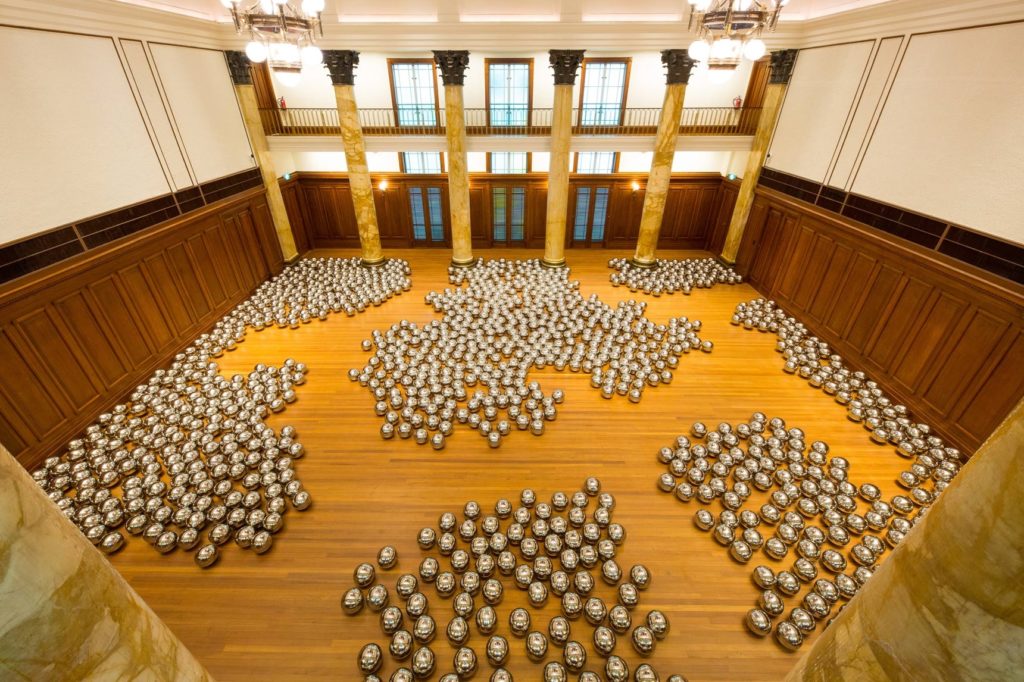Let’s take a look at one of the most interesting works in Yayoi Kusama’s career. Was it commercial or high art? A performance or an installation?
Back in 1966, Japanese artist Yayoi Kusama (b. 1929) first exhibited one of her most iconic works, Narcissus Garden. It was held during the 33rd Venice Biennale near the Italian pavilion. This work was comprised of 1,500 mirrored plastic orbs which were laid on the ground, out in the open. During the exhibition Kusama, wearing a golden kimono, stood among the orbs and sold them to visitors for two dollars each. This act may raise many questions regarding the work: Is it commercial or high art? A performance or an installation?

The name of the work is derived from Echo and Narcissus, a myth by Ovid. According to the myth, Narcissus escaped to a spring or a lake, and when he saw his reflection upon the waters of the pond, he fell in love with it and could not turn his gaze away. Narcissus Garden visualises the pond, and each visitor plays the role of Narcissus. The orbs were made for interaction, to examine one’s reflection upon them and to even purchase them.
Today many artists use mirrors in their art, from Anish Kapoor to Jeff Koons. But in 1966 it was a non-traditional art material, and to use it in a work that was exhibited in one of the most prestigious events in the art world was considered a radical idea. It is no wonder that Kusama was eventually expelled from the 33rd Biennale. She did not return until the 45th Venice Biennale in 1993.

In later exhibitions of Narcissus Garden, the artist was not present and the orbs were made of steel rather than plastic. Yet they were nothing less than impressive: In 2009 the orbs were installed in a pond in Inhotim Museum, Brazil. They floated upon the surface of the water and constantly changed their location due to the wind and other climate conditions. In 2018 MoMA presented Narcissus Garden at Fort Tilden, New York as part of its Rockaway! festival. The former industrial space, with its decaying infrastructure and graffiti writings on the wall, gets an interesting twist through the shiny silver orbs that were laid on the ground. It is somewhat reminiscent of Kusama’s rebellious act at the Biennale.

Currently the Fort Tilden exhibition is on display and is free of charge. If you plan to see this or a different exhibition of Narcissus Garden, take your time to examine the orbs, pay attention to the way the surrounding conditions affect them. You will notice the impression of the orbs as a collective is indeed one of a pond made for reflection, of both your appearance and your mind.
Learn more:
[easyazon_image align=”none” height=”110″ identifier=”1849762139″ locale=”UK” src=”https://www.dailyartmagazine.com/wp-content/uploads/2019/04/512BweyhBx8L.SL110.jpg” tag=”dail005-21″ width=”73″] [easyazon_image align=”none” height=”110″ identifier=”3791355945″ locale=”UK” src=”https://www.dailyartmagazine.com/wp-content/uploads/2019/04/61nW5ZTnA8L.SL110.jpg” tag=”dail005-21″ width=”91″] [easyazon_image align=”none” height=”110″ identifier=”B07J6PL7HR” locale=”UK” src=”https://www.dailyartmagazine.com/wp-content/uploads/2019/04/41z7O29SykL.SL110.jpg” tag=”dail005-21″ width=”82″]




